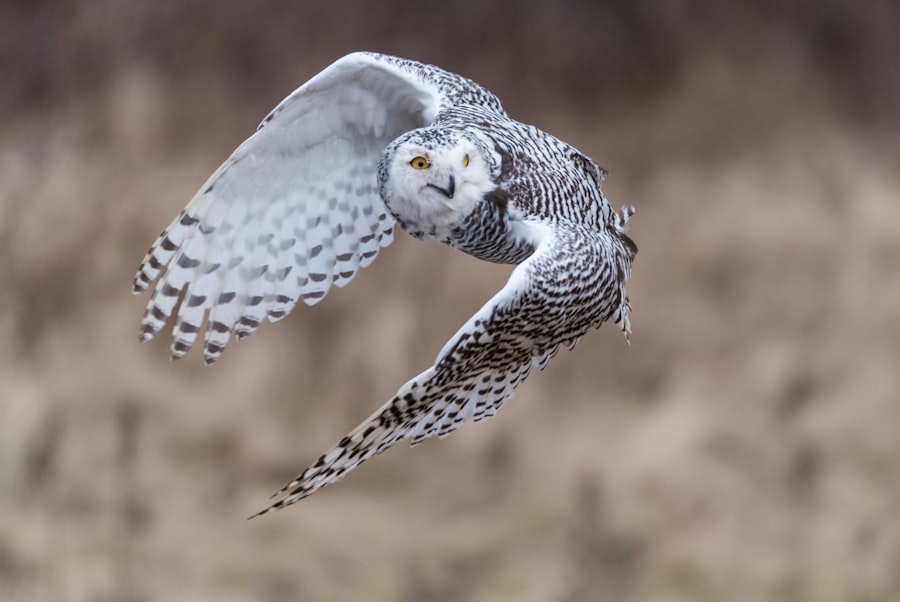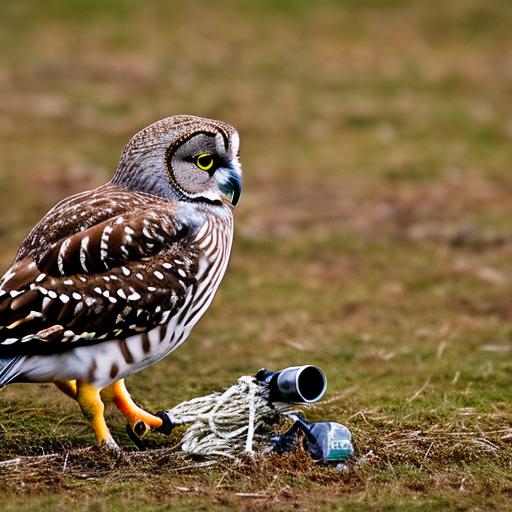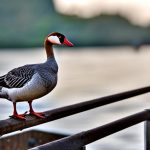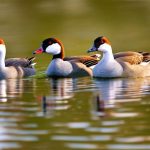Geese overpopulation has become a significant issue for property owners in many areas. These birds can cause a range of problems, from damaging lawns and gardens to leaving behind unsightly droppings. Additionally, geese can become aggressive during nesting season, posing a threat to humans and pets. As a result, property owners are constantly seeking effective methods to control the geese population and mitigate the associated problems.
Key Takeaways
- Fake owls can be an effective solution for controlling geese on your property.
- Real owls are not a practical option for bird control due to their protected status.
- Fake owls work by creating a visual deterrent for geese, making them feel unsafe and uncomfortable.
- When choosing a fake owl, consider the size, material, and design to ensure maximum effectiveness.
- Proper placement and maintenance are key to ensuring the longevity and effectiveness of your fake owl.
The Role of Owls in Bird Control
Owls are natural predators of geese and other birds, making them an ideal solution for bird control. Owls have excellent vision and hearing, allowing them to detect and hunt their prey with precision. Their presence alone can deter geese from settling in an area, as they perceive owls as a threat. This natural fear of owls can be harnessed by property owners to keep geese away.
Using owls for bird control has become increasingly popular among property owners. Many companies now offer owl decoys that mimic the appearance of real owls. These decoys are often made from durable materials and feature realistic details such as lifelike eyes and feathers. By strategically placing these decoys around their property, property owners can create the illusion of an owl presence, effectively deterring geese from settling in the area.
Fake Owls vs. Real Owls: Which is Better for Keeping Geese Away?
When it comes to using owls for bird control, property owners have two options: fake owls or real owls. Both methods have their pros and cons, and the choice ultimately depends on the specific circumstances and preferences of the property owner.
Fake owls are a popular choice due to their affordability and ease of use. These decoys are typically made from lightweight materials such as plastic or fabric, making them easy to move around and position as needed. Fake owls are also low maintenance, requiring minimal upkeep compared to real owls. However, their effectiveness may vary depending on the quality of the decoy and the intelligence of the geese in the area.
Real owls, on the other hand, offer a more natural and potentially more effective solution for bird control. Owls are skilled hunters and can actively deter geese from settling in an area. However, using real owls requires more effort and resources. Property owners must either attract owls to their property or work with a professional falconer who can provide trained owls for bird control. Additionally, real owls require proper care and attention to ensure their well-being.
How Do Fake Owls Work to Deter Geese?
Fake owls work by exploiting the natural fear that geese have of their predator. When geese see a decoy owl, they perceive it as a threat and are less likely to settle in the area. The realistic appearance of fake owls, including lifelike eyes and feathers, enhances their effectiveness in deterring geese.
There are different types of fake owls available on the market. Some decoys are stationary and can be placed on a post or other elevated surface. Others feature moving parts, such as rotating heads or flapping wings, which create a more dynamic and realistic appearance. The choice of fake owl depends on the specific needs and preferences of the property owner.
Choosing the Right Fake Owl for Your Property
When choosing a fake owl for your property, there are several factors to consider. Size is an important consideration, as larger decoys may have a greater impact on deterring geese. However, it is essential to ensure that the size of the decoy is proportionate to the area where it will be placed.
Color is another crucial factor to consider when selecting a fake owl. Owls come in various colors, ranging from light gray to dark brown. Choosing a decoy that closely matches the color of the local owl species can enhance its effectiveness in deterring geese.
Material is also an important consideration. Fake owls made from durable materials such as plastic or fabric are more likely to withstand the elements and remain effective over time. It is essential to choose a decoy that is weather-resistant and can withstand exposure to rain, wind, and sunlight.
Placement Tips for Maximum Effectiveness

Proper placement of fake owls is crucial for maximum effectiveness. Geese are intelligent birds and can quickly become accustomed to the presence of a decoy if it remains in the same location for an extended period. To prevent habituation, it is essential to move the decoy regularly.
Place fake owls in areas where geese are likely to congregate, such as near bodies of water or open fields. Position the decoys in a way that mimics the natural behavior of owls, such as perching on a post or tree branch. This will create a more realistic appearance and increase the effectiveness of the decoy.
Other Bird Control Methods to Use Alongside Fake Owls
While fake owls can be an effective solution for geese control, using them in conjunction with other bird control methods can enhance their effectiveness. Netting is a common method used to prevent geese from accessing certain areas, such as swimming pools or gardens. Scare tape, which reflects light and creates noise when blown by the wind, can also be effective in deterring geese.
Decoys of other bird species, such as hawks or eagles, can be used alongside fake owls to create a more diverse and intimidating predator presence. Additionally, employing trained dogs or using noise-making devices can further deter geese from settling in an area.
The Pros and Cons of Using Fake Owls for Geese Control
Using fake owls for geese control has its pros and cons. On the positive side, fake owls are affordable and easy to use. They require minimal maintenance and can be moved around as needed. Fake owls also offer a humane solution to geese control, as they do not harm the birds in any way.
However, the effectiveness of fake owls may vary depending on the intelligence of the geese in the area. Some geese may quickly realize that the decoy is not a real threat and become habituated to its presence. Additionally, fake owls may not be as effective in deterring geese during nesting season when the birds are more aggressive and protective of their young.
Maintaining Your Fake Owl: Tips for Longevity and Effectiveness
To ensure the longevity and effectiveness of your fake owl, proper maintenance is essential. Regular cleaning is necessary to remove dirt, dust, and debris that may accumulate on the decoy. Use a mild detergent and water to clean the surface of the fake owl, taking care not to damage any moving parts or delicate features.
Storage is another important consideration. When not in use, store your fake owl in a cool, dry place away from direct sunlight. This will prevent fading and damage to the decoy. If possible, disassemble any moving parts before storing to prevent them from becoming stuck or damaged.
Over time, the effectiveness of a fake owl may diminish due to wear and tear or habituation by geese. It is important to regularly inspect your decoy for any signs of damage or wear and replace it if necessary. By maintaining your fake owl properly, you can ensure its longevity and effectiveness in deterring geese.
Is a Fake Owl the Right Solution for Your Geese Problem?
In conclusion, using fake owls for geese control can be an effective and humane solution for property owners dealing with geese overpopulation. Fake owls work by exploiting the natural fear that geese have of their predator, deterring them from settling in an area. They are affordable, easy to use, and require minimal maintenance.
However, it is important to consider the pros and cons of using fake owls and weigh them against other bird control methods. Factors such as cost, effectiveness, and maintenance should be taken into account when deciding on the best solution for your geese problem. Additionally, using fake owls in conjunction with other bird control methods can enhance their effectiveness and provide a more comprehensive solution.
Ultimately, the choice of whether to use a fake owl for geese control depends on the specific circumstances and preferences of the property owner. By considering all available options and weighing the pros and cons, property owners can make an informed decision and effectively address their geese problem.
If you’re looking for effective ways to keep geese away, you might be interested in an article on Poultry Wizard titled “Will Fake Owls Keep Geese Away?” This informative piece explores the effectiveness of using fake owls as a deterrent for geese. It discusses whether these decoys can successfully scare off geese and provides insights into other methods that can be used to keep geese at bay. To learn more about this topic, check out the article here.
FAQs
What are fake owls?
Fake owls are decoy owls that are designed to look like real owls. They are often used as a deterrent for birds and other animals.
Will fake owls keep geese away?
Fake owls may help to keep geese away, but their effectiveness can vary depending on the situation. Geese may become accustomed to the presence of a fake owl over time, so it may be necessary to move the decoy periodically.
How do fake owls work?
Fake owls work by mimicking the appearance of a real owl, which is a natural predator of many birds and small animals. The sight of an owl can trigger a fear response in geese and other birds, causing them to avoid the area.
Where should fake owls be placed to keep geese away?
Fake owls should be placed in areas where geese are likely to congregate, such as near bodies of water or on lawns and fields. It is important to move the decoy periodically to prevent geese from becoming accustomed to its presence.
Are there any other methods for keeping geese away?
There are several other methods for keeping geese away, including using noise deterrents, applying repellents, and modifying the landscape to make it less attractive to geese. It is often most effective to use a combination of methods to deter geese.
Meet Walter, the feathered-friend fanatic of Florida! Nestled in the sunshine state, Walter struts through life with his feathered companions, clucking his way to happiness. With a coop that’s fancier than a five-star hotel, he’s the Don Juan of the chicken world. When he’s not teaching his hens to do the cha-cha, you’ll find him in a heated debate with his prized rooster, Sir Clucks-a-Lot. Walter’s poultry passion is no yolk; he’s the sunny-side-up guy you never knew you needed in your flock of friends!







